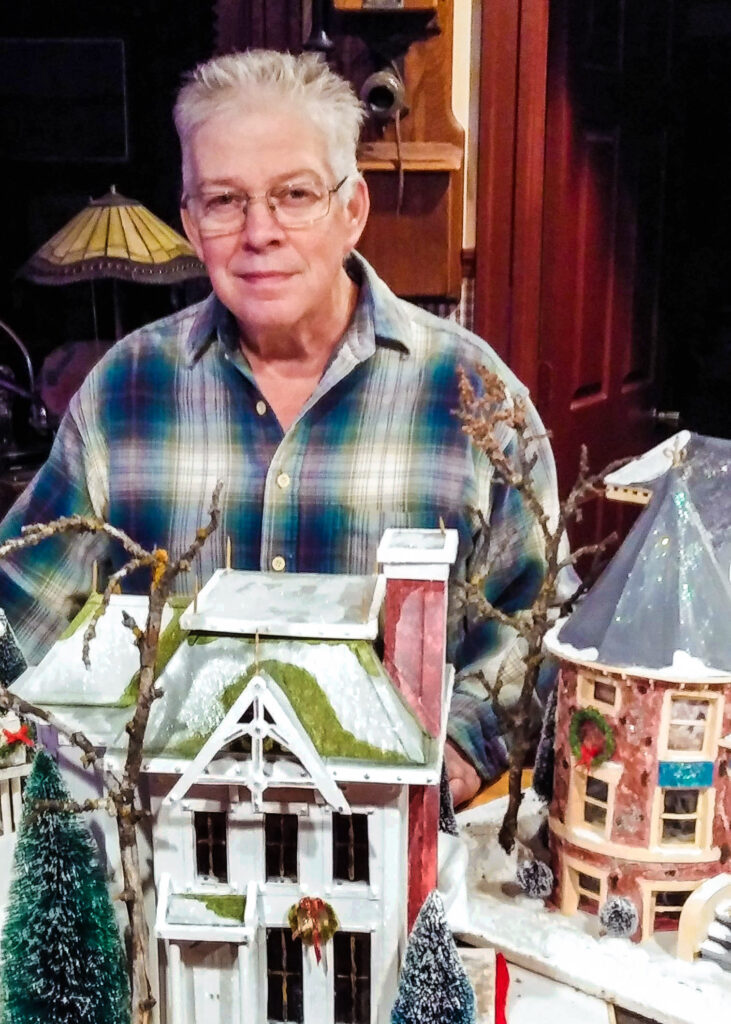
Chef Kelly Wambach is recreating tiny versions of stately Clay County landmarks based on the old Christmas tradition of “putz houses.” (Photo/Casey Leitch)
Kelly Wambach has an artistic streak and a fondness for vintage Christmas decorations. So when he, his brother and mother were taking their traditional drive on a snowy evening two years ago, the grand homes alight with Christmas décor spurred a new idea that has captivated him ever since: Recreating some of the century-old landmarks in the style of the “putz houses” of his childhood. He has been building houses – on the tiniest of scales – ever since.
“Putz houses are an old German-American tradition going back 150 years,” he explains. Families would fashion tiny villages beneath their Christmas trees around the nativity creche. The name “putz” came from the German word putzen, “to put,” but came to mean “putter around” or “decorate.” The style exploded in the years after World War II, when Japanese-made cardboard and paper houses covered in glitter became popular in American dime stores.
Never one to ignore a good idea, Kelly combined that memory with the historic homes he’d long admired. “I started whittling away at a cardboard box with an Xacto knife, glue and paper,” he says. “And suddenly a new addiction was born.” The only problem, he says, is knowing when to set them aside: “I keep finding more houses I want to replicate.”
He begins with a photo, then sketches out his own handmade version. The three-sided houses (with the back left open to insert a Christmas tree light) resemble the originals but with his own quirks. Completed, each is more or less 12 by 12 by 12 inches, considerably larger than the little commercial decorations. With trees and the rest of the surrounding landscape added, they have a footprint of about 2 feet square.
Most of Kelly’s houses have deep roots in Clay County. One is the home of his great-great-grandfather, Jacob Wambach, an early settler who built his stately residence in 1890 on the south end of Georgetown west of Highway 75. Another is based on the John Olness home, built in 1902 in Kragnes.
His most challenging by far, he says, is the stone castle of Barnesville, built by Dr. Robert Patterson in 1898, the imposing home with its turret and distinctive angles required about 120 hours of meticulous work. “I use what I have at hand,” he explains. Starting with the cardboard infrastructure, he used spackling and paint to create the stone exterior. The circles cut by a paper punch may become shingles and banisters. The faux window glass is cellophane from a package of art paper.
Other houses display more ingenious solutions. Pillars on the Wambach house? They’re bendy straws. Ornate Victorian fancywork that adorns the Kragnes house was painstakingly formed with glue-soaked string.
He uses no patterns and, he says, makes up his technique as he goes along. “I keep going until I run into a problem, then run around looking in drawers and cupboards until I find something that’ll work,” he laughs. “By the last one, I’ve gotten pretty good at shortcuts.” He adds, “I’m using a lot of those old high school geometry skills I never thought I’d need.”
The houses and other creative endeavors mark a big change from Kelly’s career. He earned a regional reputation as a chef, first at the Tree Top in Moorhead and then the Viking Oaks near the Moorhead Country Club. When that establishment closed, he and partner Evie Hanson gave it new life as the Northwood Chalet … until the building began sliding into the Red River, when they moved their operation back to the Tree Top under a new owner. Then he spent ten years operating Old Market Antiques in Moorhead before operating a lunch counter in the Hjemkomst Center until finally retiring to his new old home on a farmstead near Sabin.
But retirement proves too be a little too quiet: “I love visiting with people,” he confesses. Today he cooks two days a week at Lilac Homes in Dilworth and helps out at Cashwise Foods and the Thompson Greenhouse in Barnesville. At home, he tends capacious flower and vegetable gardens and raises goats.
He has many more Clay County landmarks on his list, but is wrapping it up for the season. “I was itching to get going in August, but didn’t want to waste the nice days I could spend in the gardens,” he says. Three houses have become his yearly limit. Yet his list is growing: “I’m going to have to do the Comstock House soon, and I have others in mind. I love Clay County history. I could go on and on with this.” But the end is coming into sight. “I have to stop at the end of December,” he reminds himself. “January is my time for housecleaning.”
To see more of Kelly’s replicas of grand Clay County houses, go to The Extra’s page on Facebook: facebook.com/theextranewspaper
– Nancy Edmonds Hanson


